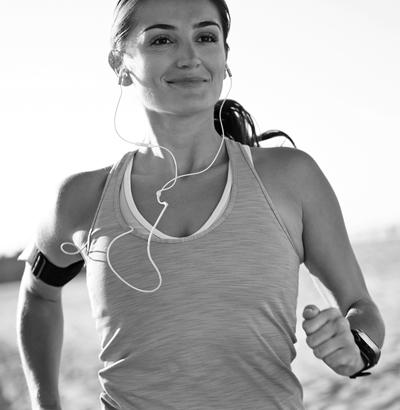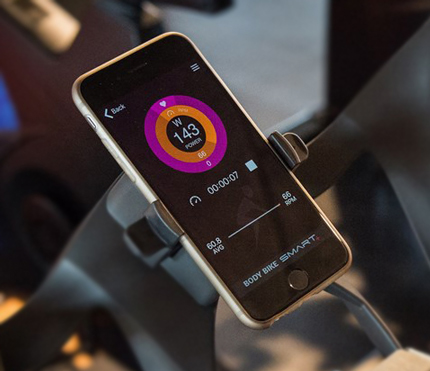Looking at the wide range of gadgets available for performance tracking and the constant development of new, smarter and lighter products, it seems that the concept is here to stay.
PERFORMANCE TRACKING, BODY BIKE® AND THE IOT
Looking at the wide range of gadgets available for performance tracking and the constant development of new, smarter and lighter products, it seems that the concept is here to stay. Many of us track our running, our biking, our walks, our sleep, how many glasses of water we drink every day and how many calories we take. You can get Bluetooth or Wi-Fi connected bathroom scales to monitor your weight and other metrics such as BMI and bodyfat, then sending the data to your smartphone. We want to be in control of our own lives and our own bodies, and to improve ourselves in areas where we might be lacking stamina. Sometimes we need motivational cues to push us a little bit further, a kind reminder that we need to take another 2,000 steps before the day is over. Connecting your data Digital natives, Millennials and other tech savvy people are perceiving the IoT as a natural part of their lives making it easier to keep track of things, communicate with each other and generally making it easier to juggle the elements involved in leading a busy life. They embrace the technological innovations as a means of entertainment as well as assisting them in their social interactions. In relation to tech gadgets for performance tracking in sport and fitness, wearables, power meters, GPS devices and connected gym equipment are all part of the IoT and this enables us to collect most of our performance data in one place, or at least a few places, making it easy to get an overview. BODY BIKE® and the IoT A still increasing number of fitness clubs is installing group training systems displaying the members’ performance data on a big screen, either for the indoor cycling studio only or for the entire cardio area (click here for a list of some of the systems compatible with BODY BIKEs). The vast majority of these systems receive the data through ANT+ as this protocol is the most suitable for the group setting. The data will typically be stored in a cloud-based account. There is still a number of systems that can only display heart rate data provided by the heart rate monitors worn by each member but most systems can display power. The power data can be picked up from e.g. the BODY BIKE® Connect or the BODY BIKE SMART®+. The performance data from the indoor bikes featuring power measurement is displayed on a fixed console on the handlebar, and to collect the data and share it on the IoT, it is necessary to connect e.g. a smartwatch or smartphone to pick up the data. BODY BIKE SMART®+ is an exception – with this bike you use your smartphone as console to display your data during workout. BODY BIKE® Indoor Cycling app is developed especially for the SMART+ bike and connects by BLE, so it can be used by iPhones as well as Android phones.* One of the advantages of using your smartphone as console on the BODY BIKE SMART®+ is that the BODY BIKE® Indoor Cycling app stores the performance data in the workout history and from here you can upload your data to Strava (link), thereby enabling the collection of all data in one place without having to have multiple connection to the bike. Connecting your smartphone to the bike is made very easy (see image). You get personal data on power, HR, distance, speed, calories and RPM – maximum and average values. The future of performance and activity tracking An even subtler wearable is the adhesive biosensor which has been around for some time but is not yet mainstream. The biosensor is attached to the skin as a temporary tattoo and it can monitor a person’s heart rate and other biometrics such as glucose and lactate levels among others, and transmit the data in real-time to a mobile or computer. So, in the future – if we stick to the road we’re on now – performance tracking may dig deeper into our biometrics and let us monitor our own health using biosensors, not to get only fitness data but also to monitor if our body is well-balanced chemically. *To receive the ANT+ signal, iPhones must have an ANT+ dongle plugged in. ANT+ reception is common in Android phones. All smartphones have Bluetooth so the bike can connect to virtually all training apps. Written by Malene JustesenPERFORMANCE TRACKING, BODY BIKE® AND THE IOT
NEWS

Keeping track of all this data is made a whole lot easier by IoT – the Internet of Things. IoT refers to the internetworking of connected devices or smart devices enabling the exchange and collection of data between them. Smart devices are electronic devices connected to each other or to a network by a wireless protocol such as BLE or ANT+.
BODY BIKE SMART®+ and BODY BIKE® Connect indoor bikes are part of IoT. Both bikes transmit your performance data during your indoor cycling class by the ANT+ protocol and SMART+ also by BLE. The data transmission can be picked up by any device able to receive these protocols and with compatible applications, and the data can be shared on other platforms e.g. an activity tracking log such as Strava and MapMyFitness among others.
What the future holds regarding performance and activity tracking is hard to tell, at least looking at 5 years from now. The advances in tech development is going at a racing pace. Wearable fitness trackers are at the top of the trend list and have been for the past two years. And within wearable technology, the development is moving towards smaller, subtler and light-weight products, e.g. smart rings, bracelets and sensors integrated in clothes and headbands to mention only a few options.